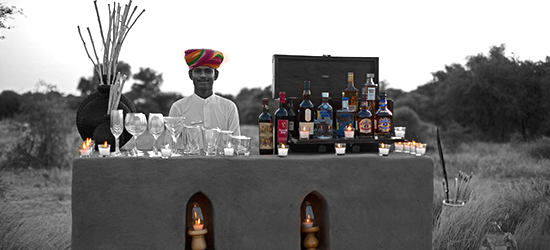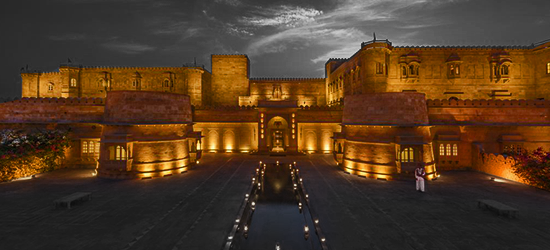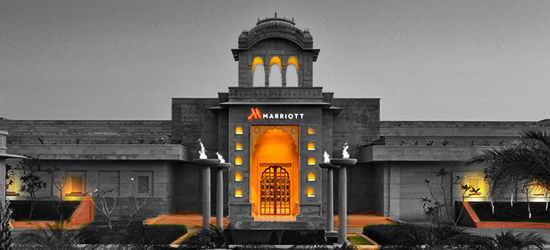
Welcome
Atithi
Ethereal Jaisalmer
Travel Ideas
Go Beyond Luxury, Feel the Opulence

Welcome
Go Beyond Luxury, Feel the Opulence
Perched at the western edge of the Great Thar Desert, Jaisalmer stands on a ridge that is regally crowned by the ancient Jaisalmer Fort. Founded by Rawal Jaisal in 1156 CE, Jaisalmer means the “Hill Fort of Jaisal.” The city is sometimes called the "Golden City of India" because of the signature yellow sandstone used in the architecture of both the fort and the houses of the town below. In the late afternoon hours, the sun imbues the entire city with a certain golden-yellow light that brings out a sense of magical beauty. The town has a bustling population of about 78,000, including the many residents of the homes inside the fort.

Set on a one hundred acre private estate of indigenous desert scrub and offering an outdoor swimming pool, a spa and wellness centre and a massage parlour, The Serai Jaisalmer is located in Jaisalmer. It features tent-like accommodation. The air-conditioned accommodation will provide you with sofa, desk and a minibar. ertain units offer a private walled–in garden and sunken, heated dip pool or a hot tub. Each canvas tent is raised on a honey coloured sandstone plinth and comes with its own terrace lounge, saturated with natural light and stylish interiors.

The majestic Suryagarh is situated in Jaisalmer. Architecturally pure and true to an ancient craft, the luxurious hotel features beautiful courtyards and grand Rajasthani architecture. The elegant rooms at the hotel come with traditional handcrafted furnishings and heritage art pieces. Rait, the region's first desert spa, provides rejuvenating massage treatments.

Built in yellow sandstone architecture in Jaisalmer, 1.4 km from Jaisalmer Fort, Jaisalmer Marriott Resort & Spa features a temperature controlled swimming pool, rooms are complete with 3 fixture bathroom while certain units at Jaisalmer Marriott Resort & Spa also boast a seating area. Wyra: Rooftop restaurant operational only at dinner, offers grills and live cooking. Dunes Bar – offering signature cocktail stations and a range of exclusive wines.
Jaisalmer Sonar Fort, the massive citadel that lies in the center of Jaisalmer, houses one fourth of the city’s residents. The fort stands amidst the sandy expanse of Trikuta Hill, and has been the scene of many battles over the centuries. Its massive sandstone walls reflect a tawny lion-like color during the day, fading to a deep honey-gold as the sun sets, thereby camouflaging the fort in the yellow desert. For this reason, it is also known as Sonar Quila or “Golden Fort.” Deep inside the fort, visitors can stroll the twisting streets, seeking out savory food treats or amazing photos.
A visit to Jaisalmer would not be complete without a jaunty Camel Ride through the desert landscape at the Sam Sand Dunes. Perhaps gaze at groups of frisky chinkaras - shy Indian gazelles - as they make their way across the silent sands. See herds of cattle and sheep roaming around, sometimes grazing, sometimes wandering, as if under the watchful eye of a greater shepherd in a cloudless sky. Most guests go out for a ride in the late afternoon, proceeding out in the sands to view a magnificent sunset in the endless golden dunes beyond Jaisalmer.
A Haveli is a gorgeous mansion owned by one of Rajasthan's wealthy merchants. These elaborate homes are etched out of sandstone with seemingly infinite details, all carved and pieced together in unique patterns. The extensive frescoes and murals that decorate the walls of the havelis would appear loud to many finer tastes, but in the arid desert where no greenery softens the cityscape, they are exquisite. Merchants imbibed color and ornamentation into their life by indulging in building mansions for themselves with intricate and lavish painted patterns. Patwon Ki Haveli is foremost among the places of interest in Jaisalmer. This is one of the largest and most elaborate Havelis in Jaisalmer and stands nestled in a narrow lane. It is five stories high and is formed of extensively carved sandstone. It is divided into six apartments; two owned by the Archaeological Survey of India, two by families who operate craft-shops, and two private homes.
is the most awaited, most famous, and certainly the most colorful cultural event in Rajasthan. Camel races, Turban-tying, and Mr. Desert competitions are organized throughout the multi-day event and authentic local food is available throughout. The festival is held every year in the month of February and attracts thousands of visitors from within India and from across the globe. It showcases Rajasthani folk songs, while Gair dancers and Fire performers are the major attractions of this desert celebration. This festival is the best time to witness performing arts like Kalbelia dances, folk songs, and music that are the signature of Rajasthani culture.
Gadi Sagar Lake is one of the most photogenic attractions in Jaisalmer. Part of its historic charm lies in the fact that it was the only source of water for the Jaisalmer city in the olden days. Artistically carved Chattris, Temples, Shrines, and Ghats surround the banks of the lake. The entrance to the Gadi Sagar Lake is through a magnificent and artistically carved yellow sandstone archway that is known as the Tilon-Ki-Pol. You may see rare migratory birds that stop for a drink at the lustrous lake which reflects the mellow amber of the picturesque sandstone banks. Just sit on any of the Ghats and watch the yellow facades change hues of magnificent ochre with the setting sun, a delightful panorama that you should not miss for the world.
Manak Chowk is a major marketplace and shopping site in the center of the fort. Manak Chowk is known for its assortment of products like leather items, antiques, textiles, handicrafts, jewelry, and many other authentic souvenirs. The shops here are small but loaded with items in various designs and colors. A visit here can also hone your bargaining skills with the local vendors.
There are seven Jain Temples situated within the Jaisalmer Fort, most of them built during the 12th and 15th centuries. Several of the most ornate buildings in Jaisalmer were built by its Jain community, including the temples dedicated to the 16th Tirthankara, Shantinath, and the 23rd Tirthankara, Parshvanath. Among these temples, the biggest is the Paraswanath Temple. Others include Chandraprabhu Temple, Rishabdev Temple, Shitalnath Temple, Kunthunath Temple, and Shantinath Temple. Known for their exquisite work of art and architecture that was predominant in the medieval era, these temples have intricate engravings adorning nearly every surface.